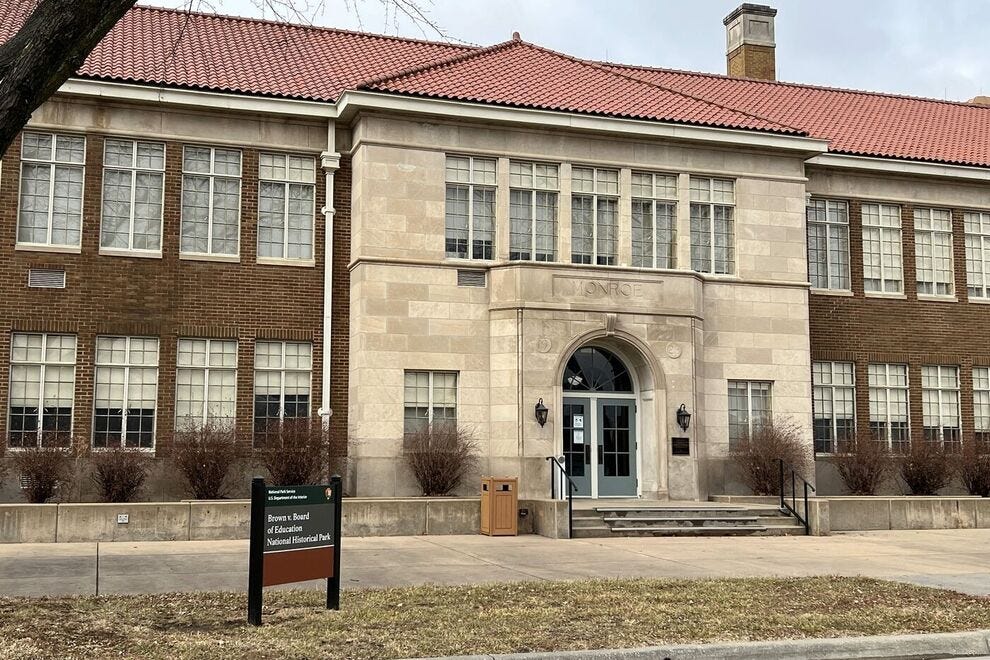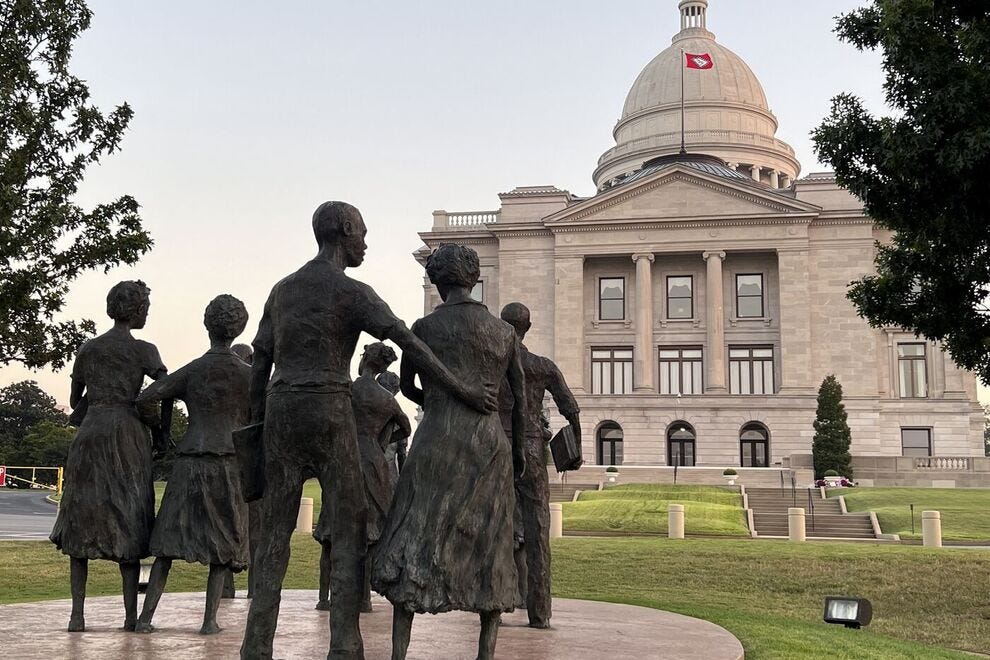
They were just trying to go to school.
But when nine Black students attempted to enter the all-white Little Rock Central High School on Sept. 4, 1957, they were turned away by the Arkansas National Guard. One of the students, 15-year-old Elizabeth Eckford, found herself surrounded by a mob of white protestors, who screamed racial slurs, spit on her and followed her to the bus stop, where she endured more vitriol and abuse before the bus finally came.
But while Little Rock Central High School became the public face of the national movement toward desegregation, what occurred in Topeka, Kansas, was the catalyst. In 1950, a group of Black parents challenged school segregation by attempting to enroll their children in all-white schools that were closer to their homes, rather than all-Black schools, like Monroe Elementary, which were farther away. Their requests were refused, but their efforts ultimately resulted in one of the most significant Supreme Court decisions in history.
Today, Little Rock Central High School and the former Monroe Elementary School in Topeka are part of the National Park System and are well worth a visit. Through videos, historic film footage, firsthand accounts, related exhibits and ranger-led tours, these sites demonstrate how the events that took place there had ripple effects that reached well beyond school walls. These sites also are part of the U.S. Civil Rights Trail.
Brown v. Board of Education National Historical Park

Today, when you walk into Monroe Elementary, closed as a school in 1975 and now the Brown v. Board of Education National Historical Park, one of the first things you see is the opinion written by Chief Justice Earl Warren: “We conclude that in the field of public education the doctrine of ‘separate but equal’ has no place. Separate educational facilities are inherently unequal.”
Most visitors begin in the auditorium, where videos focus on segregation and how it came to be, resistance to slavery and segregation, the civil rights movement and the importance of Brown v. Board of Education. The museum itself educates visitors on the events that led to Brown v. Board of Education and its aftermath, including graphic historic footage in the struggle for civil rights. Listening stations showcase protest songs by Bob Dylan, Public Enemy, Bob Marley and others. You also see a kindergarten class as it would have looked at Monroe Elementary in the early 1950s.
“The importance of this building itself is to show the similarities of Black and white schools that allowed the NAACP to challenge segregation directly,” said Park Ranger Preston Webb.
Building a case for Brown v. Board of Education

Student Linda Brown lived in a mixed neighborhood in Topeka and had both Black and white friends. But rather than being able to attend the all-white school near her home, she was forced to attend Monroe Elementary, an all-Black school, much farther from home.
The Brown family was one of 13 families recruited by the National Association for the Advancement of Colored People (NAACP) to enroll their children in white schools. All were denied admission, leading to a lawsuit in district court that they lost.
The NAACP then took the case to the Supreme Court, hoping to challenge a 1896 decision that ruled separate facilities for whites and African Americans did not violate equal protection rights guaranteed by the 14th Amendment. That “separate but equal” doctrine had emboldened Jim Crow laws, legitimizing racial discrimination and the segregation of everything from parks and drinking fountains to restaurants and neighborhoods. It also led to inferior schools for Black children, particularly in the South.
The Clark doll test

To solidify their case, the NAACP consolidated Brown v. Board of Education with four other cases (from Delaware, South Carolina, Virginia and Washington D.C.) that were based on substandard schools for Black students. Because Topeka’s Black schools, in contrast, were essentially equal to white schools, Brown v. Board of Education challenged segregation itself rather than equality, and the psychological damage it caused to Black children.
To present their case, civil rights lawyer Thurgood Marshall (who later became the nation’s first African-American Supreme Court justice) and his team used clinical research conducted by Drs. Kenneth and Mamie Clark. They used identical Black and white dolls to ask children which one they thought was nice (the majority of both Black and white children chose the white doll), ugly (most chose the Black doll), and which one they wanted to play with (the white doll). When asked which doll looked like them, Black children cried, refused to answer or left the room. Some chose the white doll.
The Supreme Court’s unanimous 1954 decision in Brown v. Board of Education reaffirmed the 14th Amendment’s “equal protection of the laws” and made it clear that the federal government would protect those rights.
In 2022, President Joe Biden signed a law that transformed the Brown v. Board National Historic Site into a national historical park and expanded the designation to include the other schools that were part of the 1954 decision.
Little Rock Central High School National Historic Site
Despite the Supreme Court’s Brown v. Board of Education decision, it was met with stiff resistance. But perhaps no place gained more international attention than Little Rock Central High School, especially after Gov. Orval Faubus called in the Arkansas National Guard to ostensibly “prevent violence.” In the weeks that followed, the National Guard was removed, more media flocked to Little Rock, and local police were left in control. When Eckford and eight of her Black classmates finally returned to school on Sept. 23, police couldn’t stop a mob of white people from rioting.
With the violence playing out on TVs across the nation, President Dwight Eisenhower federalized the Arkansas National Guard and sent a little more than 1,000 soldiers from the 101st Airborne Division to Little Rock. Soldiers escorted the Black students into the high school on Sept. 25.

In May 1958, Ernest Green, the only senior among the Little Rock Nine, became the first African American to graduate from Little Rock Central High. The ceremony was attended by Martin Luther King Jr.
“It’s been an interesting year,” Green said at the time. “I’ve had a course in human relations firsthand.”
Today, Little Rock Central High School National Historic Site is still a school, with about 2,400 students, slightly more than half of them Black.
Although the school itself is closed to visitors (except for organized tour groups), the adjacent Visitor Center offers ranger-led walking tours that bring the Little Rock Nine’s story to life, with stops on the grounds of the school, the Elizabeth Eckford Bus Bench, and the Magnolia Mobil gas station, where reporters called in their stories. The Visitor Center rounds out a visit with detailed exhibits, news footage and interpretive film and audio/video recordings of firsthand accounts, including those of the Little Rock Nine.
Also worth a stop is the Arkansas State Capitol a mile away, where statues of the Little Rock Nine defiantly face the window of the governor’s office.
The Legacy of Brown v. Board of Education

Although Brown v. Board of Education focused on public schools, it had tremendous influence, signaling the Supreme Court’s willingness to hear other segregation laws and further spurring the civil rights movement. But the struggle for racial justice continues.
“If you had told me 65 years ago that I’d still be talking about my high school graduation, I’d say you’re absolutely crazy,” said Green at a press conference attended by five members of the Little Rock Nine in September 2022. “We’re fighting the same battle. If you look at it historically, these issues have been with us since the country’s inception.”
Minnijean Brown-Trickey, another Little Rock Nine student at the press conference, added: “If we think about civil rights, anti-racism, climate change, environmental activism, they’re all about the same thing in some basic way.
“So, draw your way out of it, paint your way out of it, sing your way out of it, and do what you know and what you like to do,” she said. “We will have a better society when we have a better education for everyone.”


